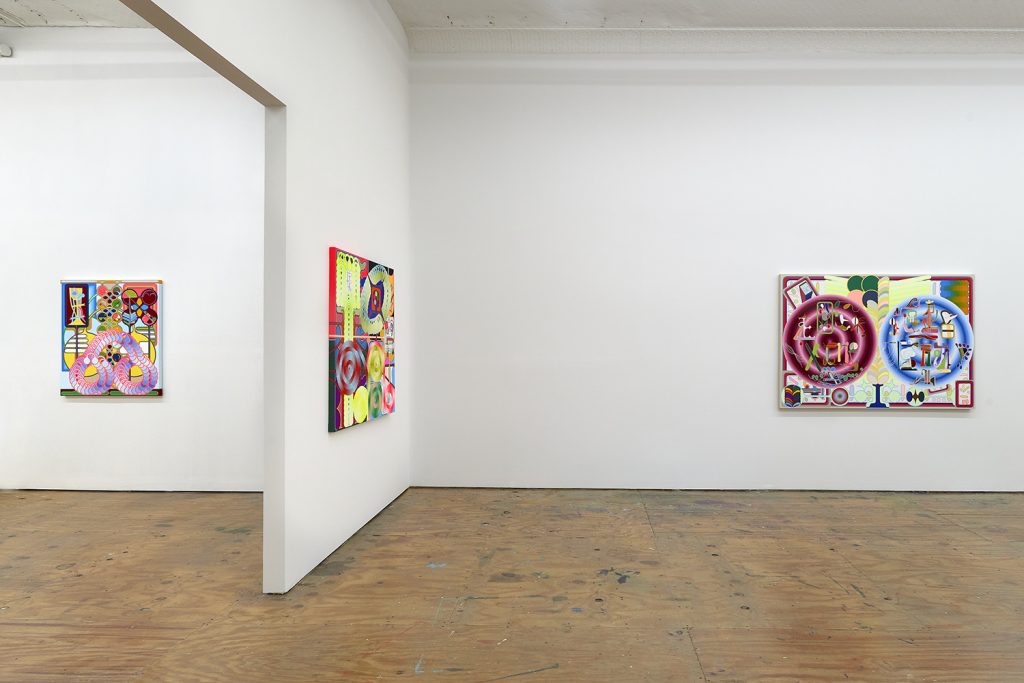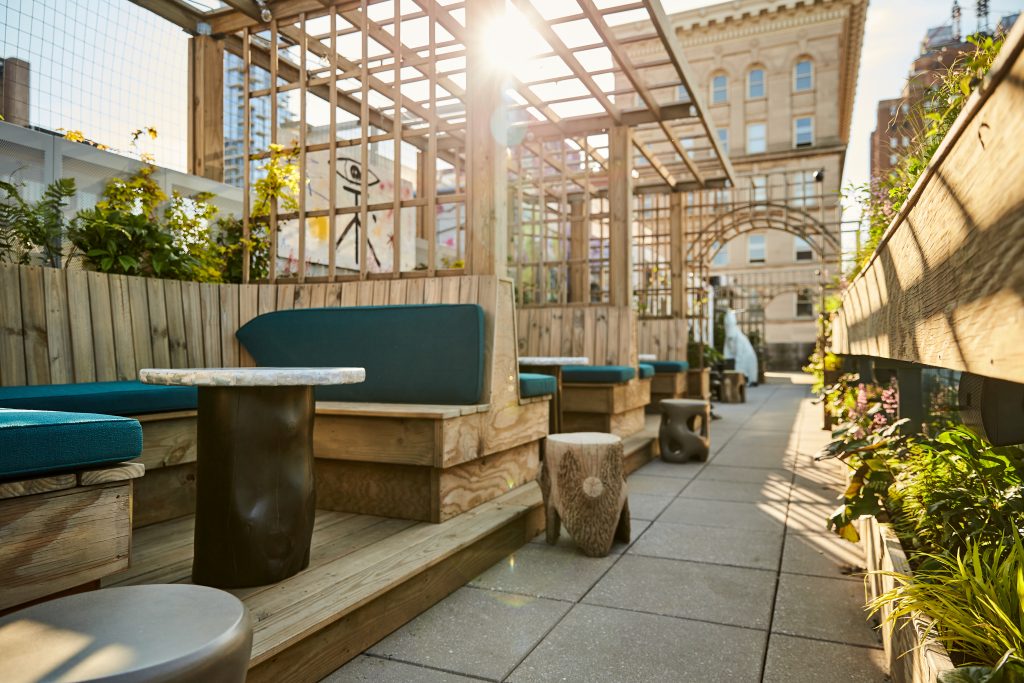The Hole NYC Founder Kathy Grayson on Her Gallery’s New Tribeca Space
A scrappy art studio transforms into a colorful inaugural show by Eric Shaw

When The Hole NYC opened the doors to artist Eric Shaw‘s bright, balanced and optimistic show Pure Mode (the inaugural exhibit at their new Tribeca location), there was a line of people waiting to step in. More than 10 years after the debut of their beloved Bowery location, The Hole welcomed people to their Tribeca destination just two weeks after founder Kathy Grayson signed the lease. It wasn’t a mad dash, however; it was a path toward new ideas and explorations with the gallery’s roster of artists. And, in many ways, it was a remedy to a gallery culture that shrunk substantially under the pandemic.

“We had been trying to open a space in LA,” Grayson tells us at the Tribeca space with her dog, Bertie. “We were trying to negotiate a lease in this gigantic building, near the gallery of my old boss Jeffrey [Deitch]. Before signing the lease, the pandemic shut everything down. I tried to push it through. I even went to LA in July and October to find some way to make it happen.” Unfortunately, it couldn’t come together.
“It was part of my 10-year plan to have two galleries,” she continues. “It’s good for a million reasons: getting into art fairs, retaining top talent, keeping your own creative energy and your creative interests by having a new structure to enact exhibitions in.” With the Bowery doing well, Grayson felt it was time to expand.

Though she was attracted to the LA art scene (which has embraced Deitch), through walks around Tribeca, Grayson began to realize the neighborhood could be a viable—if not temporary—substitute. Perusing guest books at myriad art institutions, she realized that many of the people that used to frequent the Bowery were now further downtown.
Further, art fairs continue to shutter. “We had all these solo booths planned for art fairs because as long as we can do so, we will do young section solo booths.” Many galleries at fairs show work from all their artists, but solo booths are a great way to introduce emerging talent and/or focus on the breadth of their work. Art began to pile up and Grayson decided to take a rental for six months in Tribeca and dedicate one month to each of the displaced solo booths.

That was until she saw the place The Hole now occupies. “There were tons of great spaces, super-cheap for short term,” she says. “Then I saw this space by chance and they were not open to a short-term lease at all. But this was the perfect space, so I readjusted my own plans. And then, instead of doing lost solo booths from art fairs, we decided to do gallery shows.”
“This was maybe the 12th or 15th space I saw and I knew it was perfect,” she says. Grayson was also drawn to the fact that it had been artist Peter Doig’s studio for 13 years. “It’s more than a cool anecdote; great art was made here. Whether or not that leaves a spiritual trace in addition to paint droppings, it does create a great art zone.” Still, it was a great art zone that needed to be refurbished.
“When we got here it was just a big open space,” she says. “There were two windows to a tiny, dirty alley. We buffed Peter Doig’s grime off the floor, but I wanted to preserve the art studio vibe, so now all of his paint droppings are sealed in.”

Though smaller than the Bowery location, the new space was also divided into smaller rooms to create more intimate experiences with the art. “We built the gallery to mimic cathedral architecture,” Grayson says with a laugh, “using apse-nave technology from the medieval era. With our nice little apse, we thought we could create a special mood. When people go into what feels like a back room, there’s an automatic reaction. We took advantage of the skylight there.”
Walking through Pure Mode, one quickly realizes that the precision of Shaw’s layered, colorful works play well off of the scrappy studio aesthetic. Shaw was selected as the debut artist because “his work had this feeling of optimism and ebullience that I was also feeling. Also, he had a studio full of great art and we had a great space. There was a nice coincidence that the vibe of the paintings suit the mood of the expansion.”
One of the show’s most spectacular moments comes when spotting “C’mon Clues” (2021) in the apse. It’s composed of Prussian blue, with different values of white painted into it. It feels like a minimal surprise, tucked into the corner. And, as Grayson says, “because of the reduction in colors, you can see the mechanics of the painting more.”

Grayson says, “The meaningful part to me is sharing the art with the public, and having no audience over the last year really highlights how much I was fueled by having one. Without the public, what am I doing? It’s like I’m decorating some rich people’s houses.”
The art community has been a driving force behind her mission since the earliest days on the Bowery. “I like the idea of being in a neighborhood of galleries so that you can get the whole crew of gallery-goers, because that’s important. It’s unfortunate that some of our neighbors there have moved or closed. It’s less of a circuit, but people go to Galerie Eva Presenhuber and Sperone Westwater and even over the Karma in the East Village.”

The Tribeca gallery offers Grayson so much under-explored potential. “My excitement for the space is that I could do really transformative exhibition design here. There are all these spatial ideas that I want to explore. It’s easier to transform this square footage.” This will allow for “intimate, well-proportioned and manageable shows that aren’t like a giant circus.” As Grayson notes, coming from Deitch Projects (“where everything is like ‘how do we scale this up?'”) has meant unlearning some of the desire for bigger productions.
The Tribeca space also alleviates pressure. “If I am just focused on the Bowery, there will be artists and ideas that are left out. We have our whole rest of the year planned out over there. With the art fairs canceled, it would have meant that we couldn’t do so much of what we wanted to do.”

Reflecting on her last 10 years, Grayson says, “I kept waiting to the feel the sense of accomplishment. I created that 10-year plan. To me, I was checking the boxes of success that I had prescribed to myself. But it does not feel like that. Opening at the Bowery was an explosion of chaos and 100% faking it until you make it in every department. This Tribeca space was no problem. It was all so easy because we’ve done it so many times. The fact that it was so easy, I think, that’s the accomplishment.”
Pure Mode will run through 15 May at 86 Walker Street
Images courtesy of The Hole NYC












